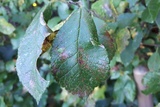Phyllonorycter spinicolella (Zeller, 1846) Species
Last modified: March 3, 2024, 3:31 p.m.
A widespread and fairly common species throughout Belgium.
Details
- Classification
- Family: Gracillariidae > Subfamily: Lithocolletinae > Genus: Phyllonorycter > Species: Phyllonorycter spinicolella
- Vernacular names
- Sleedoornvouwmot (NL), Sloe midget (EN)
- Synonyms
- Phyllonorycter pruniella (Herrich-Schäffer, 1855) and Phyllonorycter pomonella sensu auct., nec (Zeller, 1846)
- First mention in Belgium
- Fologne E. 1859b. Supplément au catalogue des lépidoptères de Belgique. — Annales de la Société entomologique belge 3: 133–142. On page 142 (as Lithocolletis spinicolella. Stainton). view page
- Status
-
Native
Distribution
Imago
Head brown, mixed with white haires; forewing ground colour brown, with a pattern consisting of a straight basal streak; a white patch on dorsum near the base; four costal and three dorsal striae, finely edged with dark brown scales basally; a patch with dark brown scales in the apical area.
Museum specimens
No pictures yet!Specimens in nature
No pictures yet!Mine
A rather large (ca. 12 mm), tentiform mine between two secondary veins on the underside of a leaf, many tiny longitudinal folds, light green to green. The leaf is contorted much in later stages. Upperside of the mine light green or white. The dark frass is concentrated in a corner of the mine.
See also gracillariidae.net and bladmineerders.be.
Cocoon/pupa
The last instar of the summer generation makes a loose spinning, that of the autumn generation construct a tough, white cocoon without applying any frass.
Bionomics
The species hibernates in the larval stage inside the cocoon, between leaf litter on the ground. Pupation in spring. After emergence of the adult, the pupal skin protrudes through the mine.
Flight periods
The adults fly in two generations a year: in May and in August–September.
Observed on
- Host plant (species):
- Prunus spinosa
- Host plant (genera):
- Prunus
The larva lives mainly on Prunus spinosa, but can also be found on other Prunus species.
Habitat
The species used to be recorded especially from the limestone area, but since the larval host plant is planted as an ornamental plant, the species spread all over the country. It has been found at forest edges, in gardens and parks.

